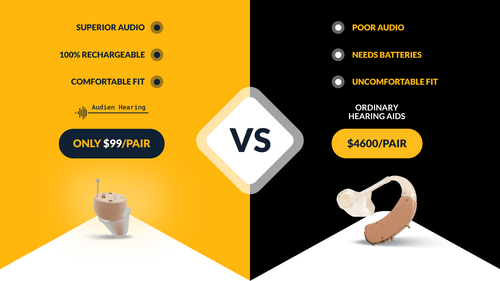So you suffer from hearing loss. Welcome to the club of more than 40 million Americans and hundreds of millions more worldwide.
While hearing loss is never a fun thing to deal with, there are some great solutions out there. This comprehensive hearing aid guide will cover everything there is to know about the best hearing aids to buy online. Read on to learn more about prices, brands, types of hearing aids, and everything else you need to know to find the right solution for you.
Comprehensive Hearing Aid Guide
Since there is a lot to consider when learning about hearing aids, we put together a guide for you that covers different types of hearing aids, prices, and more. Click the links below for more information on each topic.
- What Are Hearing Aids?
- How Hearing Aids Work
- New To Hearing Aids?
- Where To Buy Hearing Aids
- Analog vs. Digital Hearing Aids
- Types of Hearing Aids
- Hearing Aid Prices
- Audien Hearing Aids
What Are Hearing Aids?

According to WebMD, hearing aids are a “battery-powered electronic device designed to improve your hearing”. Hearing aids can be beneficial for most ranges of hearing loss.
Hearing aids come in a wide variety of different technologies, designs, shapes, and sizes. Keep reading to learn more!
How Hearing Aids Work

Hearing aids consist of three different parts:
1. The Microphone
A hearing aid microphone picks up incoming sound waves and converts them into an electrical signal that can be sent to the amplifier.
2. The Amplifier
The amplifier receives the signals from the microphone and amplifies the power of them, sending them to the speaker.
3. The Speaker
The speaker takes the sounds sent via the amplifier and plays them directly into the ear.
New To Hearing Aids?

If you're new to hearing aids, it can feel like a lot to digest. We put together some informational resources for you to use to make the transition a bit easier.
We've also compiled some of the common issues people encounter when adjusting to a new pair of hearing aids and resources to help solve these problems.
Preventing Feedback
When inserting a new pair of hearing aids, feedback is a widespread problem. We encourage you to keep the volume low and keep pressure off the microphone as you insert them into your ear to minimize feedback. Additionally, finding the right ear tip size is crucial; if you don't use a tip that forms a proper seal, you will likely experience feedback.
For further information on preventing feedback, read our article "3 Steps To Prevent Feedback When Inserting Your Hearing Aids".
Getting Used To New Hearing Aids
It takes time and effort to get used to wearing a new pair of hearing aids. It's a big change adjusting to new sounds and new devices in your ears all day!
When adjusting to your new hearing aids, it's important to find the right fit for you. That includes finding the perfect ear tip, finding the right fit for the device in your ear canal, not wearing them for too long right away, and more.
For more information on getting used to hearing aids, read our article "7 Tips To Get Used To Your New Hearing Aids".
How To Properly Clean & Care For Your Hearing Aids
Since hearing aids are something you use every single day, it's important to use proper practices for maintenance. This includes cleaning your devices, replacing ear tips as needed, and keeping them charged, so they're always ready to go when you need them!
For further information on hearing aid maintenance, read our article "How To Properly Clean & Care For Your Hearing Aids".
Where To Buy Hearing Aids

So you think you need a pair of hearing aids, where can you buy a pair?
Today, it's easier than ever to get a pair of hearing aids. You can now order a pair online (with online hearing tests included as a part of the process) or in-person via an audiologist at a hearing center.
Buying Hearing Aids Online
Buying a pair of hearing aids online has never been easier. Major hearing brands like Starkey still don't allow the ability to order online but offer great online hearing tests that help diagnose the user's hearing loss and point them toward a provider they can schedule an in-person appointment with to buy.
Brands like MDHearingAid.com offer powerful, digital, one-size-fits-all hearing aids in the range of $500-$1,000 for a pair available for purchase entirely online. They also offer their own online hearing test.
Several brands sell hearing aids online and fall in a lower price range ($500 or less). At Audien Hearing, we strive to make it as easy as possible to order online while keeping costs lower than everyone else (as low as $89/pair), so hearing is more accessible for everyone.
Buying Hearing Aids From an Audiologist
For as long as hearing aids have been around, this has been the traditional way to buy a pair. The process involves going to a local hearing center, taking a hearing test, and getting diagnosed by an audiologist, then working with an audiologist and/or sales rep to find a hearing aid that meets your needs and budget.
This process leads to the highest possible standard of care for hearing loss, as the hearing aids can be custom programmed based on your audiogram. Hearing aids purchased from an audiologist tend to have advanced digital functionality for improved sound quality. That said, going this route is much more expensive than buying direct online.
Analog vs Digital Hearing Aids

All hearing aids are either digital or analog. Analog hearing aids convert sound into an analog signal, whereas digital hearing aids convert sound into a digital signal. Generally, digital hearing aids are more expensive because the microchip has more advanced processing capabilities.
Analog Hearing Aids

Analog hearing aids convert sound into an analog signal and amplify all sounds in the same way. While Audien Hearing doesn’t make any programmable analog hearing aids, there are some analog hearing aids that may have this feature. These devices allow the installation of pre-made programs designed for different settings, such as sitting at home watching TV or out at a loud restaurant.
Digital Hearing Aids

Digital hearing aids convert sound into a digital signal and actually produce a digital copy of the sound that is processed. These hearing aids feature a more advanced chip that allows for better processing and customization specifically based on a user’s audiogram. These devices are typically the most expensive ones you’ll see on the market.
Types of Hearing Aids

There are many different types of hearing aids, aside from the digital vs. analog classification. Below we’ll dive into the different types and styles of hearing aids and which ones may be best suited for you.
Rechargeable Hearing Aids

Rechargeable hearing aids are quickly gaining popularity in the market and becoming the preferred choice of consumers. That said, according to HearingTracker.com, a whopping 89% of consumers still use hearing aids with disposable batteries. Furthermore, they report that 70% of consumers prefer rechargeable hearing aids, suggesting a gap in the market to be filled in the coming years.
At Audien Hearing, we only make rechargeable hearing aids to help meet the consumer preference for more discreet, convenient, and easy to use devices.
Read more about rechargeable hearing aids in our comprehensive rechargeable hearing aid report.
Disposable Battery Powered Hearing Aids

Currently, the vast majority of the market uses hearing aids powered by disposable batteries. Until just a few years ago, the major hearing aid manufacturers mostly sold only battery-powered devices.
Today, amid the shift in consumer preference toward rechargeable devices, disposable battery-powered hearing aids are produced less and less.
Consumers generally don’t prefer disposable battery devices for a handful of reasons:
Cost
Disposable hearing aid batteries generally last only a few days to a week at a time. That means millions of people are spending money every year, just for batteries. Many spend anywhere from $50 to $100 per year on batteries, depending on the device.
Convenience
Hearing aids with disposable batteries can be very inconvenient. If you run out of batteries and don’t have any on hand, your hearing aid is rendered useless. That’s why many prefer rechargeable devices because they usually last all day on a full charge.
However, the only advantage that disposable batteries pose is that if you keep batteries on hand, you’ll never be out of juice or waiting for a charge. This could be handy for people who are not often nearby a power source.
Ease of Use
Hearing aid batteries are quite small and can be difficult to replace. Given that many hearing aid users sometimes have problems like arthritis or limited dexterity, a rechargeable hearing aid poses the benefit that users will no longer have to fiddle with tiny batteries.
Bluetooth Hearing Aids

As the title implies, these hearing aids use Bluetooth, a wireless communication method between electronic devices, to provide enhanced features and functionality for hearing aid users. Bluetooth hearing aids have the capability to sync with phones, TVs, other streaming devices, and more. This means users with Bluetooth hearing aids can take calls and even watch movies and shows directly via their hearing aids.
Bluetooth hearing aids often also have the ability to sync with a smartphone, allowing users to adjust volume, programs, and more from their phones.
Typically, these hearing aids are on the higher end of the price spectrum, ranging from around $500 to $5,000 per pair.
Completely in Canal (CIC) Hearing Aids

Completely in canal (CIC) hearing aids are designed to fit completely in the ear canal. Generally, CIC devices are suitable to help people with mild to moderate hearing loss.
CIC hearing aids are the smallest and least visible type of hearing aid. They are often limited in functionality and rely on disposable batteries due to their small size.
While CIC hearing aids are technically custom-molded for the ear, because most people have varying sizes and shapes of ear canals, there is a category of OTC CIC hearing aids that describes in-ear devices that aren’t custom made. We believe our Audien EV1 and EV3 hearing aids fall in the OTC CIC hearing aid category.
In the Canal (ITC) Hearing Aids

In the canal (ITC) hearing aids are halfway between CIC hearing aids and ITE hearing aids. They are still designed to fit your ear canal but are not small enough to be fully inserted.
ITC hearing aids offer a minimal and discreet look for users but are slightly bigger, allowing for enhanced functionality and usability. These devices may still be tricky to use due to their size but are bigger and easier to use than their CIC counterparts.
ITC hearing aids are generally made custom for the user and only sold by major hearing aid manufacturers that do custom fittings.
In the Ear (ITE) Hearing Aids

In the ear (ITE) hearing aids are custom-molded to fit the ear canal and the outer bowl of the ear. There are multiple styles, some that fit within the entire bowl of the ear, and some that fit only within part of the ear.
These devices are noticeably bigger than CIC or ITC devices, and can include extra functionality for this reason. Additionally, they may have better battery life and can be easier to use.
True ITE hearing aids are generally only purchased through major hearing aid manufacturers are at higher prices in the thousands due to the customized nature of these products.
Behind the Ear (BTE) Hearing Aids

Behind the ear (BTE) hearing aids are hearing devices that sit behind the ear, featuring a tube and earpiece that insert comfortably into the ear canal. BTE hearing aids are typically the largest type of hearing aid and also feature the most advanced functionality.
BTE hearing aids are the most popular type of hearing aid on the market currently. BTE hearing aids often have advanced processing capabilities, directional microphones, and other features to enhance sound quality and clarity.
Smaller, rechargeable BTE devices are becoming more prevalent, but consumer preference also seems to be trending toward in-ear devices.
Receiver in Canal (RIC) Hearing Aids

Receiver in canal (RIC) hearing aids are similar to BTE devices, except instead of using simple tubing connected to an earpiece, RIC hearing aids use a wire connected to a receiver that sits in your ear canal.
The fit and form is almost exactly like BTE devices, but the tube encases a wire, and the earpiece encases a receiver that fits in the ear.
Generally, this style of device tends to be slightly smaller than BTE devices due to some of the technology being housed in the receiver. Keeping the receiver in the canal can lead to improved clarity relative to BTE devices. That said, BTE devices generally offer stronger amplification.
Hearing Aid Prices

Hearing aid prices are a big factor when it comes to choosing the proper device for you. The average price of hearing aids is $4,600 per pair, with more expensive devices costing anywhere from $5,000 to $10,000! Below you can read more about hearing aid prices and products available in different price ranges.
Average Price of Hearing Aids

For years, the average price of a pair of hearing aids has been $4,600. This is because, until recently, a handful of the big hearing companies had a monopoly on the industry.
Major hearing aid manufacturers work with audiologists, hearing centers, sales reps, affiliates, and more to sell their hearing aids. Adding the cost of a physical location, audiologists, support staff, and more leads to insanely high costs of $4,600 per pair on average.
Many people have spent $6,000, $7,000, or more on hearing aids! That’s the biggest purchase most Americans ever make aside from their home and vehicle.
For some people, especially those with severe to profound hearing loss, advanced hearing aids may be the only option. Going through audiologists will offer you the highest quality hearing aid and customization based on your level of hearing loss. However, for millions of people, a device costing thousands of dollars isn’t an option.
At Audien Hearing, our goal is to cut out the middle man. No more audiologists, sales reps, fancy features, customizations. We offer a one size fits all product that around 90% of our customers love and use regularly. Our lower-end model is only $89/pair, and our best one is $249/pair.
The one size fits all approach may not work for everyone, but it has certainly helped thousands of our customers to improve their lives, and we will continue to work to provide a low-cost option for those who can’t afford expensive hearing aids.
Why Do Hearing Aids Cost So Much?

For years, hearing aids have cost more than $4,600 on average for a pair, according to AARP. That's a shockingly high price tag for most Americans facing hearing loss!
This is because a few major manufacturers generally dominate the hearing aid industry. These manufacturers work with audiologists, hearing centers, and sales reps to provide consumers with a place to get their hearing tested. This provides high-quality hearing solutions customized to your level of hearing loss, but involving audiologists, hearing centers, and salespeople raises the price tag significantly.
The Best Cheap Hearing Aids

If you have a budget of $1,000 or more, you may want to read elsewhere to find a hearing aid. At Audien Hearing, our focus is to make and offer affordable hearing aids for those who can’t afford traditional devices.
There are a few brands that make products in the $500 to $1,000 price range. Our favorite is probably MDHearingAid - they offer features like Bluetooth, digital technology, and more. For those with the budget to do so, we recommend giving a higher-end option a try! But if you want to keep the price lower, we think we have the best cheap hearing aids on the market.
If you’re looking for affordable hearing aids, we recommend you check out our products here.
Audien Hearing Aids

Audien Hearing aids are designed to be the highest possible quality at the lowest possible price. At Audien, all our products are rechargeable hearing aids with a small in-ear design. We strive to continue releasing improvements in our devices while keeping costs at the lowest on the market.
Will Audien Hearing Work For Me?
The short answer is: it depends. Based on a hearing test, you can tell what kind of hearing loss you have and across which frequency. For most people with mild to moderate hearing loss, Audien Hearing should work for you. It may not work for those with severe to profound hearing loss or perhaps extremely high-frequency hearing loss.
We recommend getting a hearing test to assess your level of hearing loss. For most levels, you can give Audien Hearing a try, and if they successfully work for you, you'll save thousands! If not, send them back for a full refund, and we'll even recommend another brand for you to try out.

Our most popular product, the Audien EV1 Hearing Aid, has helped more than 50,000 people to improve their hearing. It is currently one of the most popular hearing solutions in the world!
This hearing aid is small and discrete, with a strong rechargeable battery and solid amplification.
Visit here to learn more about the EV1 Hearing Aid.
Audien EV3 Hearing Aids

The Audien EV3 Hearing Aid is our latest and greatest achievement. We listened to the feedback from thousands of customers regarding our EV1 and worked with top engineers and hearing manufacturers to design something smaller, more comfortable, easier to use, and with better sound quality.
The EV3 hearing aid checks all the boxes, and it features a sleek, improved design that is 26% smaller than the EV1. The hearing aid comes with a wireless charging dock that can charge both devices at once. It also features enhanced sound quality and amplification across a broader spectrum of sound frequencies.
Visit here to learn more about the EV3 hearing aid.
Conclusion
In summation, finding a hearing aid can be quite an intimidating experience. Nobody likes having to sift through all the different articles, products, websites, and more trying to find something that works for them.
That’s why we compiled everything that we can right here - to give you the information you need to make this important decision!
Hopefully, you now have a better idea about hearing aids and can make a knowledgeable decision. If you have severe to profound hearing loss, you may be better off looking into a high-end manufacturer that can customize a device for you.
But if you are looking for something that costs $250 or less, you might want to give Audien Hearing a try! We encourage you to learn more about our products here.
At the end of the day, our #1 mission is to make hearing affordable for everyone. We want to make sure you’re aware of all the options out there, but if you want to find something on a budget, check out Audien Hearing. We have thousands of happy customers for a reason - hopefully, you will be one too!
Susan Wright
Senior Editor, Audien Hearing













